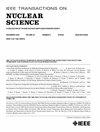IF 1.9
3区 工程技术
Q3 ENGINEERING, ELECTRICAL & ELECTRONIC
引用次数: 0
摘要
同步辐射光源通常使用由直流热离子电子枪驱动的 100-MeV 常导线性加速器,用于大电流应用。此类系统是电子源的稳健解决方案;然而,它们往往具有复杂的束流系统,从而增加了复杂性和总体成本。在这项工作中,我们提出了一种方法,将非相对论束流直接注入相对加速结构,该结构与最佳频率失谐。这种失谐会导致相位跃迁,从而实现与传统多结构束流系统相当的光束参数,如传输和能量扩散。所提出的解决方案简化了纵向波束动力学,避免了对复杂束流系统的需求。这种设计的简洁性和尺寸的减小使所提出的解决方案对紧凑型电子源很有意义。文章以瑞士光源(SLS)100兆电子伏注入式直列加速器的升级为例,提出了一种可能的解决方案。本文章由计算机程序翻译,如有差异,请以英文原文为准。
Design Study of a Compact Injector for a Synchrotron Light Source
Synchrotron light sources are commonly fed with 100-MeV normal conducting linear accelerators powered by a dc thermionic electron gun for high current applications. Such systems are robust solutions for electron sources; however, they tend to have complex bunching systems that increase the complexity and overall cost. In this work, we propose an approach where nonrelativistic bunches are directly injected into a relativistic accelerating structure that is detuned from the optimal frequency. This detuning causes a phase jump, enabling the achievement of beam parameters, such as transmission and energy spread, comparable to those obtained with conventional multistructure bunching systems. The proposed solution simplifies the longitudinal beam dynamics and avoids the need for complex bunching systems. The simplicity and reduced size of this design make the proposed solution interesting for compact electron sources. The article proposes, as an example, a possible upgrade of the Swiss Light Source (SLS) 100-MeV injection linac.
求助全文
通过发布文献求助,成功后即可免费获取论文全文。
去求助
来源期刊

IEEE Transactions on Nuclear Science
工程技术-工程:电子与电气
CiteScore
3.70
自引率
27.80%
发文量
314
审稿时长
6.2 months
期刊介绍:
The IEEE Transactions on Nuclear Science is a publication of the IEEE Nuclear and Plasma Sciences Society. It is viewed as the primary source of technical information in many of the areas it covers. As judged by JCR impact factor, TNS consistently ranks in the top five journals in the category of Nuclear Science & Technology. It has one of the higher immediacy indices, indicating that the information it publishes is viewed as timely, and has a relatively long citation half-life, indicating that the published information also is viewed as valuable for a number of years.
The IEEE Transactions on Nuclear Science is published bimonthly. Its scope includes all aspects of the theory and application of nuclear science and engineering. It focuses on instrumentation for the detection and measurement of ionizing radiation; particle accelerators and their controls; nuclear medicine and its application; effects of radiation on materials, components, and systems; reactor instrumentation and controls; and measurement of radiation in space.
 求助内容:
求助内容: 应助结果提醒方式:
应助结果提醒方式:


